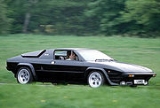
Lamborghini Silhouette
Encyclopedia
The Lamborghini Silhouette P300 was a two-door
two-seat
mid-engined
rear-wheel drive sports car
, made in small numbers by Lamborghini
between 1976 and 1979.
Officially presented at the 1976 Geneva Auto Show, the Silhouette began as a styling exercise by noted Italian carrozzeria
Bertone. It was based on the earlier Lamborghini Urraco
, but was distinguished from the Urraco by more angular styling. The Silhouette was the first Lamborghini to employ a targa top
roof. The Silhouette later evolved into the similar looking but more successful Lamborghini Jalpa
. The car had a 3.0 litre all-aluminium alloy
Lamborghini V8
internal-combustion engine mounted transversely
behind the driver. Of the 54 units built (only 12 with right-hand drive), 31 are currently known to exist.
Official performance figures indicate the Silhouette could complete the 0 to 100 km/h (0 to 62.1 ) sprint in 6.5 seconds, 0 to 100 mph (0 to 44.7 ) in 16.1 seconds, and could reach a top speed of 260 kilometre per hour

Vehicle door
A vehicle door is a partition, typically hinged, but sometimes attached by other mechanisms such as tracks, in front of an opening which is used for entering and exiting a vehicle. A vehicle door can be opened to provide access to the opening, or closed to secure it. These doors are similar to...
two-seat
Car seat
A car seat is the chair used in automobiles. Most car seats are made from inexpensive but durable material in order to withstand as much use as possible.-Ergonomy: Lumbar and thigh support:...
mid-engined
Mid-engine design
A mid-engine layout describes the placement of an automobile engine between the rear and front axles. Another term for this is mid-ship.-Benefits:The mid-engine layout is typically chosen for its relatively favorable weight distribution...
rear-wheel drive sports car
Sports car
A sports car is a small, usually two seat, two door automobile designed for high speed driving and maneuverability....
, made in small numbers by Lamborghini
Lamborghini
Automobili Lamborghini S.p.A., commonly referred to as Lamborghini , is an Italian car manufacturer. The company was founded by manufacturing magnate Ferruccio Lamborghini in 1963, with the objective of producing a refined grand touring car to compete with established offerings from marques like...
between 1976 and 1979.
Officially presented at the 1976 Geneva Auto Show, the Silhouette began as a styling exercise by noted Italian carrozzeria
Coachbuilder
A coachbuilder is a manufacturer of bodies for carriages or automobiles.The trade dates back several centuries. Rippon was active in the time of Queen Elizabeth I, Barker founded in 1710 by an officer in Queen Anne's Guards, Brewster a relative newcomer , formed in 1810. Others in Britain included...
Bertone. It was based on the earlier Lamborghini Urraco
Lamborghini Urraco
The Lamborghini Urraco was a sports car manufactured by Italian automaker Lamborghini in the 1970s. It was introduced at the Turin auto show in 1970 but wasn't available to buyers until 1973....
, but was distinguished from the Urraco by more angular styling. The Silhouette was the first Lamborghini to employ a targa top
Targa top
Targa top, targa for short, is a semi-convertible car body style with a removable roof section and a full width roll bar behind the seats. The term was first used on the 1966 Porsche 911 Targa, and it remains a registered trademark of Porsche AG....
roof. The Silhouette later evolved into the similar looking but more successful Lamborghini Jalpa
Lamborghini Jalpa
The Lamborghini Jalpa is a sports car produced by the Italian sports car manufacturer Lamborghini from 1981 to 1988.-Overview:The Jalpa was a development of the earlier Silhouette intended to fill a role as a more "affordable" Lamborghini, being much less expensive than the flagship Countach and...
. The car had a 3.0 litre all-aluminium alloy
Aluminium alloy
Aluminium alloys are alloys in which aluminium is the predominant metal. The typical alloying elements are copper, magnesium, manganese, silicon and zinc. There are two principal classifications, namely casting alloys and wrought alloys, both of which are further subdivided into the categories...
Lamborghini V8
Lamborghini V8
The Lamborghini V8 is a ninety degree V8 petrol engine designed by Lamborghini, for their less-expensive vehicles. It was only the second internal combustion engine ever developed by the company, and first saw production for the 1971 Lamborghini Urraco. It was designed by Gian Paolo Dallara...
internal-combustion engine mounted transversely
Transverse engine
A transverse engine is an engine mounted in a vehicle so that the engine's crankshaft axis is perpendicular to the long axis of the vehicle. Many modern front wheel drive vehicles use this engine mounting configuration...
behind the driver. Of the 54 units built (only 12 with right-hand drive), 31 are currently known to exist.
Official performance figures indicate the Silhouette could complete the 0 to 100 km/h (0 to 62.1 ) sprint in 6.5 seconds, 0 to 100 mph (0 to 44.7 ) in 16.1 seconds, and could reach a top speed of 260 kilometre per hour


